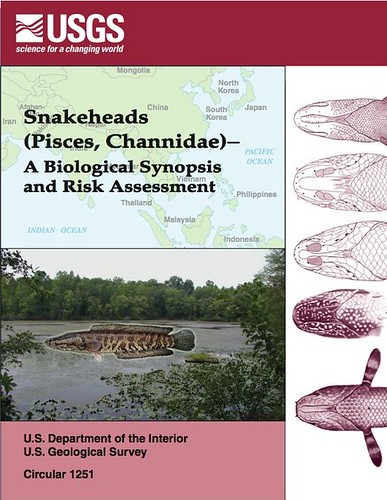ISBN 0-607- 93720.

Image adapted from USGS - NAS Species FactSheet. Accessed on 23rd May 2007.
SNAKEHEADS (PISCES, CHANNIDAE) - A BIOLOGICAL SYNOPSIS AND RISK ASSESSMENT.
This compact 143 paged circular is not a taxonomical treatment of the Channidae (a family of freshwater fishes commonly known as snakeheads), but does cover all 29 currently known species and provides the most complete coverage of the family at present. It is basically a compilation of available current literature and anecdotal information from various sources. Nonetheless, the authors highlight the state of the taxonomy of certain taxa or species complexes (e.g., Channa gachua, C. striata). This circular comprises of a systematic discourse that covers literature review and background information, the various uses in the trade, highlighting on U.S. importations, U.S. regulations as of July 2002, potential range in U.S., risk
assessment process, and species accounts of all known 29 channid species from Asia and Africa.
The accounts of introduction of feral populations of channids in USA is highlighted and treated in detail. The research was exhaustive and made interesting accounts to read. The authors also highlight the earlier mistaken identity of Channa maculata, which had been introduced to Hawaii in the late 1800s. The potential impact of feral populations is also highlighted and discussed upon. One of the more interesting chapters was on the history of introductions, which highlights the high likelihood of introductions through the live food fish trade. Certain species of channids have the ability to survive out of water up to 72 hours, to traverse over dry land, to breath atmospheric air and to tolerate cooler temperatures.
Nevertheless, there are some flaws. The native range of Channa cyanospilos depicted (p. 68) is misleading, as it includes both Peninsular Malaysia and Borneo; whereas current knowledge is that this species is endemic to Sumatra (unpublished data). The native range of Channa gachua (p. 72) should include Sumatra and Sarawak (in the western part of Borneo)(unpublished data). The range of Channa micropeltes (p. 98) should include central Sumatra and East Kalimantan (in the eastern part of Borneo)(unpublished data). There were a few instances of inconsistencies in the use of cited authors’ names, e.g. p.92 – Inger & Kong, Inger & Chin. Both refer to the same authors, and the correct citation should be Inger & Chin, 1962. Another set of cited authors’ names was quoted wrongly – Martin-Smith & Hui, should be Martin- Smith & Tan, 1998.
If this circular is to be intended as a visual guide for fisheries biologists and government enforcement officers, the diagrams of the channids need to be improved. Original depictions from the 1800s can be misleading and chromatically inaccurate. Live, fresh and preserved specimen depictions would provide better visualizations.
Despite the few drawbacks, however, this circular is a good set of data for every fisheries biologist, ichthyologist, biologist, advanced hobbyist and concerned environmentalist to have on their bookshelf.
Literature Cited
Inger, R. F. & Chin, P. K., 1962. The freshwater fishes of North Borneo. Fieldiana, Zoology, 45: 1-268.
Martin-Smith, K. M. & H. H. Tan, 1998. Diversity of freshwater fishes from Eastern Sabah: Annotated checklist for Danum Valley and a consideration of inter- and intra-catchment variability. Raffles Bulletin of Zoology, 46(2): 573-604.
Tan Heok Hui
Department of Biological Sciences
National University of Singapore
Kent Ridge, Singapore 119260, Republic of Singapore
First published in The Raffles Bulletin of Zoology Vol. 52(1): 282 on 30 Jun 2004.

No comments:
Post a Comment